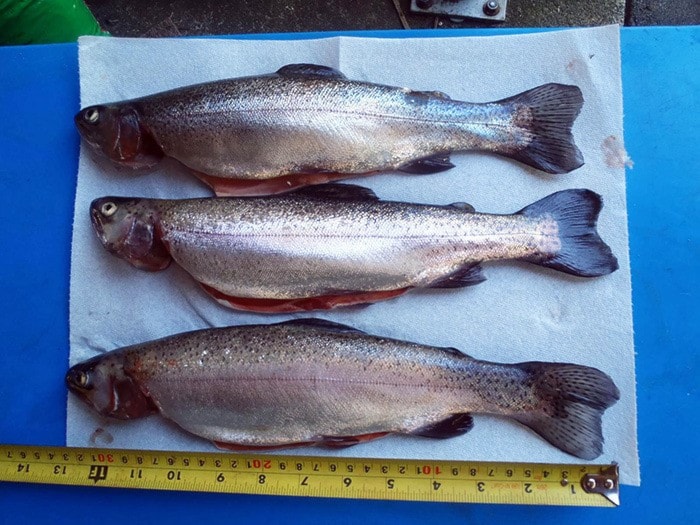I was casually looking at the solunar tables when I noted that on May 30 there was a major period beginning around 9 a.m. My next move was to carefully suggest to Elaine that it might be a good time for me to go trout fishing; although I rarely go fishing on popular lakes on the weekend. She agreed as long as I was prepared to provide fresh trout for supper.
On Saturday morning I left home just after 6:30 a.m. so I could find a place to park on a weekend. I arrived at my chosen lake shortly after 7 a.m. and was fishing by 7:30. One of the things that surprised me was that the parking lot was empty and I was the first boat on the lake. There was a brisk wind out of the Northwest and it was chilly in spite of the cloudless sky and warm weather forecast.
I started with my “go-to” caddis pupae pattern and a dragonfly nymph, both patterns on sinking lines. After a half hour of fishing and no action I changed the nymph to a #14 black micro leech. At about 9 a.m. I had a firm hit on the small leech and eventually fooled the eagle and netted a prime 13 inch one-meal trout.
I noted that the bite co-coincided with the beginning of a major solunar period. During the next hour I took another nice trout on the small leech pattern. There was very little surface action and I was beginning to wonder if the bite was going to materialize.
I had not had any action on my sedge pupae so I changed it to bright red leech pattern a friend had given me. I soon had a solid hit on the new pattern, but the fish didn't stay around. As noon approached I netted another prime fish taken on the new pattern – from under the persistent passes of a determined eagle.
By noon I had three prime one meal trout in my fish box and it was time to consider my options. The picture with the column is of the three 13-inch trout that made for a memorable morning fishing. As I played the fish the eagle did its best to pick them off my line, but by allowing the fish to swim well below the surface prior to netting, I succeeded in keeping my fish. A technique I use to keep the fish below the surface is to play the fish with the rod horizontal to the lake surface as much as possible, this tends to allow the fish to swim well below the surface as you prepare to net it. On this occasion it was three fish for Ralph and zero for the eagle.
When you find time to look at the world of nature around you, from the comfort of a small anchored boat, it is amazing what you see. I think I saw a first for me as I sat in my little punt and watched a small bat feed on insects along the shoreline at shortly after 12 noon. Another first for this season was a large loon that came by the boat as I enjoyed my lunch. There is so much more to fishing than catching fish.
Last week I received a phone call from a fisher who reads the column and he recounted an experience he and his wife had on Maple Lake. They saw a small plume of smoke coming from a spot on the shore near the path. They landed their canoe and with plastic bags extinguished a small fire that could have had serious consequence for our Maple Lake forest. A special “Thank You” to this caring couple – and a plea to smokers and others – PLEEEEEZE!!! be careful with fire in our tinder-dry forests.
Ralph Shaw is a master fly fisherman who was awarded the Order of Canada in 1984 for his conservation efforts. In 20 years of writing a column in the Comox Valley Record it has won several awards.
